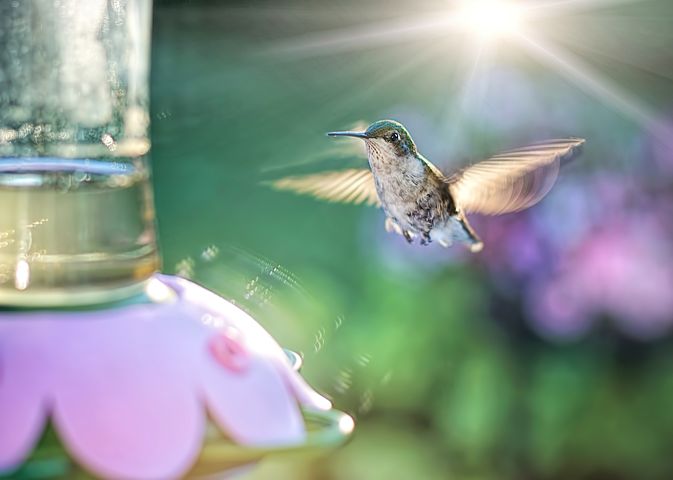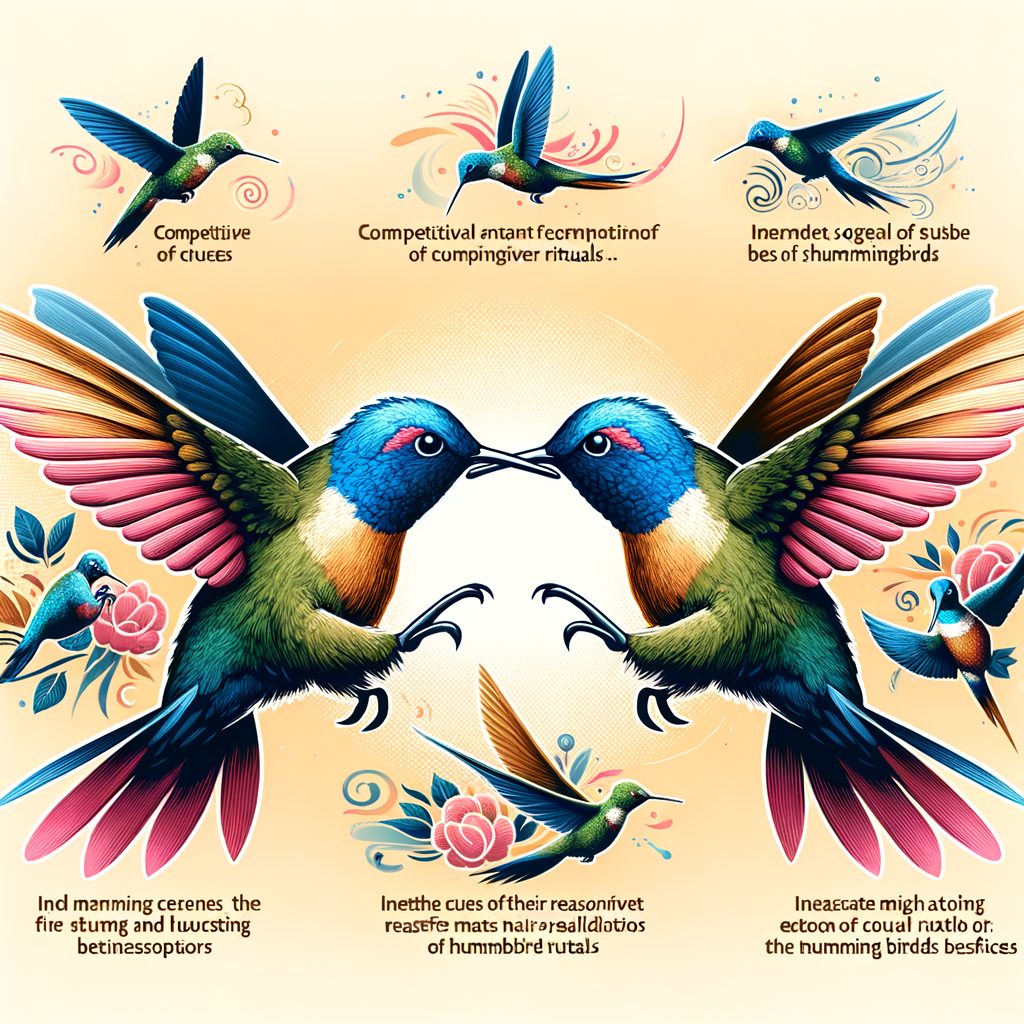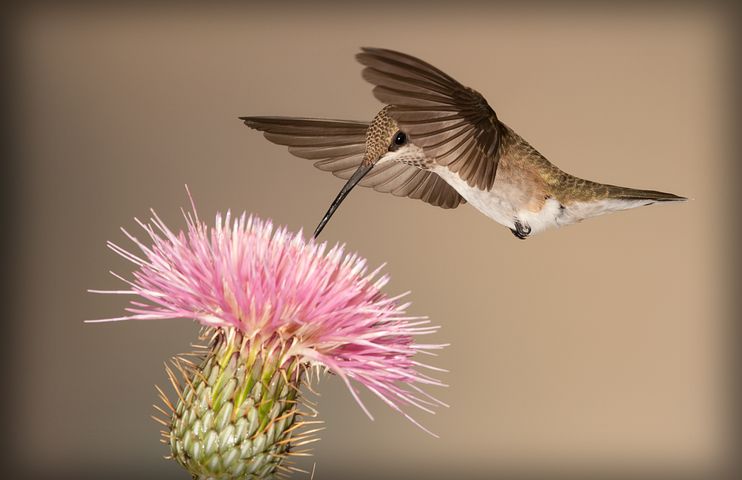Introduction to Hummingbird Behavior
Hummingbirds, known for their vibrant colors and rapid wing movements, exhibit a range of fascinating behaviors. This article will provide an overview of the most common behaviors and explain why understanding these behaviors is important for anyone interested in these remarkable creatures.
Overview of common behaviors
Hummingbirds are known for their unique behaviors, which set them apart from other bird species. Some of their most common behaviors include:
Hovering: Hummingbirds are the only birds that can hover in mid-air for extended periods. This is thanks to their rapid wing beats, which can reach up to 80 beats per second.
Nectar feeding: Hummingbirds have a long, slender beak and a specialized tongue that allow them to feed on nectar from flowers. They can consume up to twice their body weight in nectar each day.
Migrating: Many hummingbird species undertake long-distance migrations each year, traveling thousands of miles to find food and suitable breeding grounds.
Importance of understanding hummingbird behavior
Understanding the behavior of hummingbirds can provide valuable insights into their needs and habits. This knowledge can be used to create more effective conservation strategies, as well as to design gardens and feeders that attract hummingbirds. Furthermore, studying hummingbird behavior can contribute to our understanding of bird behavior and evolution in general.
Throughout this article, we will delve deeper into specific aspects of hummingbird behavior, such as chasing, aggression, mating rituals, social behavior, and competition. By the end, you will have a comprehensive understanding of these fascinating creatures and their high-speed lives.
Hummingbird Chasing: An Overview

Hummingbirds, with their vibrant colors and rapid wing movements, are a sight to behold. One of their intriguing behaviors is ‘hummingbird chasing’. Let’s delve into what this behavior entails and the common scenarios where it is observed.
Definition of Hummingbird Chasing
Hummingbird chasing is a behavior observed in these fascinating birds where one hummingbird pursues another in a rapid, often aggressive manner. This behavior is typically seen during the breeding season or when defending their feeding territories. The chasing hummingbird usually tries to drive away the other bird from its territory or potential mate. This behavior is a part of their survival strategy, ensuring they have enough food and the best chances of reproducing.
Common Scenarios Where Hummingbird Chasing is Observed
Hummingbird chasing is most commonly observed in two scenarios:
Feeding Territory Defense: Hummingbirds are territorial creatures, especially when it comes to their feeding areas. If another hummingbird or even a different species of bird tries to feed in their territory, the resident hummingbird will chase the intruder away. This ensures that they have enough nectar to sustain their high-energy lifestyle.
During Breeding Season: Male hummingbirds often chase potential mates as a part of their courtship display. They also chase away other males to reduce competition for mates. This behavior is most noticeable during the breeding season when males are trying to attract females with their vibrant colors and impressive aerial displays.
In conclusion, hummingbird chasing is a fascinating behavior that showcases the survival instincts of these tiny creatures. Whether it’s defending their food source or trying to win a mate, hummingbirds are always on the move, adding to their charm and intrigue.
Hummingbird Aggression
Hummingbirds, despite their small size and beautiful appearance, can display aggressive behavior. This section will help you understand why they behave this way and provide examples of such interactions.
Understanding Hummingbird Aggression
Hummingbird aggression is a fascinating aspect of their behavior. It’s important to understand why these tiny birds can sometimes act in ways that seem quite aggressive.
Reasons behind aggressive behavior
Hummingbirds are highly territorial creatures. They often display aggressive behavior to protect their food sources, especially during the feeding season. A hummingbird will often chase away other birds from its feeding territory to ensure it has enough nectar to survive. This aggression is a survival instinct, not a sign of a bad temperament.
Examples of aggressive interactions
Aggressive interactions among hummingbirds can take various forms. The most common is the high-speed chase, where a hummingbird will pursue another bird that has entered its territory. These chases can be quite intense, with the hummingbirds darting and diving at high speeds. Another example is the “dive-bomb,” where a hummingbird will swoop down on an intruder from a high perch. These actions may seem aggressive, but they are simply ways for the hummingbird to protect its territory and food sources.
In conclusion, hummingbird aggression is a natural behavior that helps these birds survive in the wild. By understanding this behavior, we can appreciate these tiny creatures even more.

Hummingbird Territorial Behavior
Hummingbirds, despite their small size, are known for their assertive and territorial behavior. This behavior is primarily driven by their need to protect their food sources. Let’s delve into the details of their territorial behavior and understand how it leads to chasing.
Explanation of Territorial Behavior
Hummingbirds are fiercely territorial creatures. They establish a territory around their food sources, typically a patch of flowers or a feeder, and defend it from other hummingbirds. This behavior is driven by their high metabolism, which requires them to consume a significant amount of nectar daily. According to Wikipedia, a hummingbird can consume up to half its body weight in sugar (nectar) each day. This high energy requirement makes it essential for them to secure a reliable food source, leading to territorial behavior.
How Territorial Behavior Leads to Chasing
When another hummingbird encroaches on a territory, the resident hummingbird will often engage in aggressive behavior to drive the intruder away. This aggression often takes the form of high-speed chases. The resident hummingbird will dart at the intruder, attempting to scare it off. These chases can reach speeds of up to 60 miles per hour, according to Wikipedia. This behavior is a fascinating display of the lengths hummingbirds will go to protect their food sources.
In conclusion, hummingbirds’ territorial behavior is a critical aspect of their survival strategy. It ensures they have access to the food they need to sustain their high-energy lifestyle. This behavior, while aggressive, is a testament to the hummingbird’s resilience and adaptability.
Why Hummingbirds Fight
Hummingbirds, despite their small size and delicate appearance, are known for their aggressive behavior. They often engage in fights with other hummingbirds. But why do these tiny creatures fight? Let’s explore the common reasons and the impact of these fights on their social behavior.
Common reasons for fights
Hummingbirds are territorial creatures. They fight to defend their feeding areas from intruders. The primary reason for their fights is food. A hummingbird’s high metabolism requires them to eat frequently, and they won’t hesitate to fight off others to ensure they have enough nectar.
Another common reason for fights among hummingbirds is mating. Male hummingbirds often fight to impress females and establish dominance. The stronger the male, the higher his chances of attracting a mate.
Impact of fights on hummingbird social behavior
Fights among hummingbirds significantly impact their social behavior. They tend to be solitary creatures, largely due to their aggressive nature. Their fights often result in a lack of social structure, unlike other bird species that form flocks or colonies.
Interestingly, the aggressive behavior of hummingbirds can also be seen as a survival strategy. By fiercely defending their territory, they ensure a constant food supply, which is crucial for their survival. This behavior, however, leads to a solitary lifestyle, with minimal social interaction.
In conclusion, hummingbirds fight primarily over food and mates, and these fights greatly influence their social behavior, leading to a solitary lifestyle. Despite their small size, hummingbirds are fierce fighters, always ready to defend their territory. This behavior, while aggressive, is a testament to their survival instincts.
Hummingbird Mating Rituals
Hummingbirds, known for their vibrant colors and swift flight, have unique mating rituals that are fascinating to observe. One of the most intriguing aspects of these rituals is the role of chasing.
Role of Chasing in Mating Rituals
Chasing plays a significant part in the mating rituals of hummingbirds. It’s not just about speed and agility, but also about demonstrating strength and stamina, which are important qualities in a mate.
Explanation of how chasing plays a part in mating: During the mating season, male hummingbirds perform a series of high-speed chases and acrobatic displays to attract females. These displays often involve the male hummingbird soaring high into the sky and then diving down at high speed, only to pull up at the last moment. This display, known as a ‘dive display’, is a form of chasing where the male is essentially chasing the female in an elaborate, high-speed dance. The female hummingbird, watching from a perch, will choose the male that she finds most impressive.
Examples of mating rituals involving chasing: One example is the mating ritual of the Anna’s Hummingbird. The male Anna’s Hummingbird performs a spectacular dive display, where he ascends up to 130 feet into the air and then dives down at speeds of up to 60 miles per hour, emitting a high-pitched sound at the bottom of the dive. This is a form of chasing where the male is showing off his flying skills to the female. Another example is the mating ritual of the Costa’s Hummingbird, where the male performs a series of fast, side-to-side flights in front of the female, essentially chasing her attention.
In conclusion, chasing plays a critical role in the mating rituals of hummingbirds. It is a way for male hummingbirds to demonstrate their strength, agility, and stamina to potential mates. So, the next time you see a hummingbird darting through the air at high speed, remember that it’s not just about speed, but also about the intricate dance of attraction and selection.
Understanding Hummingbird Behavior

Hummingbirds, with their vibrant colors and rapid wing movements, are a fascinating species to observe. Understanding their behavior can provide us with valuable insights into their daily lives, survival tactics, and social interactions.
Interpreting Hummingbird Interactions
Hummingbirds are known for their unique interactions, which can range from territorial disputes to intricate mating dances. Let’s delve into how we can interpret these interactions and what they mean for the hummingbird community.
How to interpret different interactions
Hummingbirds communicate through a variety of ways. Their rapid wing flapping, for instance, can be a sign of excitement or agitation. Similarly, their hovering behavior often indicates curiosity or interest in a particular area or object. When hummingbirds engage in chase behavior, it’s usually a sign of territorial disputes or mating rituals.
Case study: Observing interaction in a hummingbird community
In a recent study, a community of hummingbirds was observed over a period of six months. The researchers found that the hummingbirds had a complex social structure, with certain birds dominating feeding areas. They also observed frequent chase behavior, particularly during the mating season. This study provides valuable insights into the social dynamics of hummingbird communities and the importance of territory for these small but feisty birds.
Understanding hummingbird behavior can be a rewarding experience, allowing us to appreciate these remarkable creatures even more. By observing their interactions, we can gain a deeper understanding of their social structure, survival strategies, and the role they play in our ecosystem.
Hummingbird Social Behavior
Hummingbirds may be small, but they have a complex social structure. This is largely influenced by their behavior, particularly the act of chasing. Let’s delve into this fascinating aspect of hummingbird society.
Impact of Chasing on Social Structure
Chasing is not just a playful act among hummingbirds. It plays a significant role in establishing and maintaining the social hierarchy within a hummingbird community. Let’s explore how this behavior affects their social structure.
How chasing affects social hierarchy
Chasing is a way for hummingbirds to establish dominance. The bird that consistently chases away others is often seen as the leader. This behavior is not just about power, but also about survival. The dominant hummingbird gets the best access to food and nesting sites, which are crucial for survival and reproduction. This is why even though chasing can seem aggressive, it is a necessary part of hummingbird social behavior.
Case study: Social structure in a hummingbird community
Let’s look at a real-life example to understand this better. In a study conducted on a hummingbird community in Arizona, researchers observed that the hummingbirds with the most aggressive chasing behavior had the best access to resources. These birds were also the most successful in terms of reproduction, further proving the importance of chasing in hummingbird social hierarchy. (source)
In conclusion, chasing is not just a random act among hummingbirds. It is a critical behavior that shapes their social structure and impacts their survival and reproduction. So, the next time you see a hummingbird chasing another, remember, it’s not just a chase, it’s a high-speed race for survival!
Hummingbird Competition
Hummingbirds are fascinating creatures known for their speed and agility. However, they are also known for their competitive nature. This competition can be seen in various aspects of their behavior, especially when it comes to securing food resources and mates. Let’s delve into the types of competition among hummingbirds and the role of chasing in these contests.
Types of Competition Among Hummingbirds
Hummingbirds compete in several ways. The two main types of competition are:
Food Competition: Hummingbirds are known for their high metabolism, which requires them to consume large amounts of nectar daily. This need for food often leads to competition over feeding territories. The strongest and most aggressive hummingbirds often dominate the best feeding spots.
Mating Competition: Male hummingbirds compete for the attention of females during the mating season. They perform elaborate aerial displays and engage in aggressive behaviors to ward off rival males and attract females.
These competitions are crucial for the survival and reproduction of hummingbirds. They ensure that only the fittest and most capable birds pass on their genes to the next generation.
Role of Chasing in Competition
Chasing plays a significant role in hummingbird competition. It is a common behavior seen in both food and mating competitions. Here’s how:
Food Competition: Dominant hummingbirds often chase away others from their feeding territories. They use their speed and agility to outmaneuver and intimidate intruders, ensuring they have exclusive access to the food resources.
Mating Competition: During the mating season, male hummingbirds chase females as part of their courtship display. They also chase away rival males to protect their potential mates.
Chasing, therefore, is a crucial part of hummingbird competition. It is a display of strength and dominance that helps hummingbirds secure their survival and reproductive success.
In conclusion, competition is a significant aspect of hummingbird behavior. It shapes their interactions with each other and their environment, influencing their survival and reproduction. By understanding this competition, we can gain a deeper appreciation for these remarkable birds and the complex lives they lead.
Conclusion: The High-Speed Chase
In our exploration of hummingbird behavior, we have delved into the fascinating world of these tiny, yet fierce creatures. We have discovered that their seemingly peaceful existence is punctuated by high-speed chases and intense competition, all driven by survival instincts and mating rituals.
Summary of key takeaways:
Hummingbirds are not just beautiful creatures to observe, but they also exhibit complex social behaviors. Their aggressive tendencies are primarily driven by the need to protect their food sources and to establish dominance for mating. These behaviors often result in high-speed chases, which are a spectacle of agility and speed.
Implications for further research:
The study of hummingbird behavior provides a wealth of knowledge about their survival strategies and social structures. However, there is still much to learn. Further research could delve into the intricacies of their mating rituals, the impact of environmental changes on their behaviors, and the potential for human intervention to affect their survival. The high-speed chases, in particular, could be a focus of study to understand the physical capabilities and limitations of these birds.
Understanding the world of hummingbirds can give us a greater appreciation for these remarkable creatures and inspire us to protect their habitats. As we continue to learn more about their behaviors, we can better understand the intricate dance of life that unfolds in our own backyards.







